ASHA Convention – Informative and Entertaining, With Just The Right Touch Of Glamour
Tuesday, February 26, 2008
by Leeann Mione
LEXINGTON, Ky. - The ASHA Convention, held at the Embassy Suites Hotel in Lexington, Ky., Feb. 14-16, 2008, was a “feel good” experience from beginning to end. With entertaining guest speakers, numerous well-deserved awards presented, open and informative board meetings and general membership meetings and the grand Saddlebred Ball Saturday night, ASHA worked hard to make this a “must do” on everyone’s calendar.
Events kicked off Thursday morning with numerous committee meetings and a welcome reception Thursday evening which was sponsored by the FEI Disciplines Committee.
Friday morning the schedule started with the Amateur/Owner/Trainer Open Forum. ASHA Executive Secretary Alan Balch began the forum and introduced the panel, Smith Lilly, Joan Lurie, Bob Ruxer, Anne Judd and Eitan Beth-Halachmy.
Balch also gave special thanks to presenting sponsors of the convention, Melissa Moore and Dr. Margaret McNeese. Will Wood, from ASHA, was on hand to coordinate the live webcast of the convention on the ASHA web site.
Approximately 75 people attended the forum. Cards were passed out to those in attendance so they could write down questions for the panel that were answered at the end.
Joan Lurie spoke about training the in-hand colt and started her presentation by recommending that anyone wanting to learn to show an in-hand entry should get Jim Aikman’s tape. “It’s a wonderful example of how to start a colt,” said Lurie. She shared some of her experiences and told what training methods work best for her. Two of the points she emphasized were to make sure to keep the babies happy and healthy and to make them feel as if the trainer is their ‘safe place’ in order to establish trust. “If they’re going to put on a good horse show, it has to come from inside them.”
Anne Judd spoke about how to select a show horse and relayed a story about why it is important to choose the right horse for the client, not the trainer. She encouraged prospective buyers to make a checklist before shopping for horses and to stick to it.
“You have to put emotions aside. Don’t be afraid to ask questions,” said Judd. Items on her checklist included: observing behavior in the stall if possible, observing how a horse loads or at least asking that question of the seller, price, size, purpose, way of moving and soundness.
Smith Lilly discussed bits and bitting and brought a wide variety of bits to show the crowd. He began by giving two principles of bits: “First, use the least amount of bit that will get the job done and second, the thicker the bit, the milder. The thinner the bit, the more severe.”
He listed nine points to consider when using a full bridle. 1.) Thickness of the mouthpiece on the curb bit. He suggested wrapping the curb with latex and the latex with electrical tape to protect it, in order to make the bit less severe. 2.) Height of the port and width of the bit. Too wide or too narrow both cause problems. The port has to leave enough room for the tongue. 3.) Length of the shanks. Longer shanks are more severe. 4.) Relationship between the upper and lower ports. A shorter top is more severe. 5.) Roughness of the mouthpiece. 6.) Weight of the bit. The heavier stainless steel bit is more severe than the lighter weight aluminum bit. 7.) Fitting the curb chain to the bit. The rougher the curb chain, the more severe it is. A leather strap is less severe than a metal chain. 8.) Tightness of the curb chain. 9.) Where you put the bit in a horse’s mouth. Placing a bit lower in a horse’s mouth makes it more severe.
Eitan Beth-Halachmy spoke of “self-carriage”, meaning a horse who does it by himself. He agreed with Lilly on the difficulty of choosing bits. “I have 300 bits but only use one, because I don’t know what the other 299 do,” he joked.
He spoke of the influence that a rider’s body language has on a horse. “If I can communicate with a horse’s feet instead of his head, I can prevent a lot of communication error. I can move all four feet with my body. Don’t rely completely on the bit to do the job,” he said. He suggested learning where one foot is placed because if you know the proper cadence of each gait, you’ll then know where the other three feet are at any given time.
Bob Ruxer’s topic was “Far-Sighted Thoughts From A Near-Sighted Trainer”. He began by saying today’s trainers are better than ever and included stallions, mares, veterinarians, blacksmiths, headsets, quality and judging in that statement.
He continued by saying, “We have horses in the public eye that move like never before, but we’re always asking ‘How can we tighten these screws?’ We’ve raised the bar, but we’re losing our horse. They enter the ring earlier and trot higher than ever before, but we’re losing the ‘engine’ – the back end.
Ruxer also asked the question regarding promotion of the breed. ”If we suddenly had two million dollars in our ‘promotion’ department, how many people think we would really see our breed grow?”
Friday’s Awards Luncheon hosted a big group on hand to see presentations of the FEI Disciplines Awards, USDF (United States Dressage Federation) All Breeds Awards, ASHA National Pleasure Awards and ASHA Charter Club Of The Year Award.
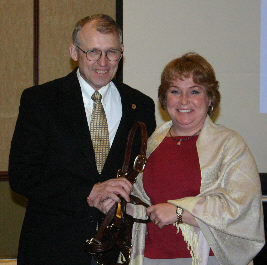
Paula Briney accepted the FEI Disciplines
Award from Fred Sarver for Pratense’s Rejoice
in the first level dressage division.
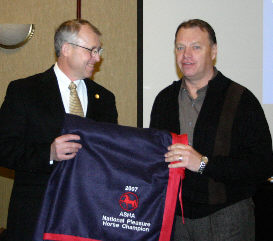
Andy Freseth picked up several ASHA National
Pleasure Awards on behalf of the customers
of Hollow Haven Farm.
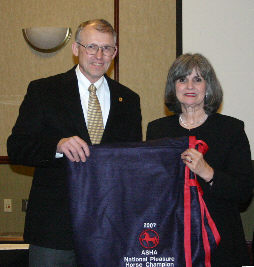
Kathryn Nichols accepted the Show Pleasure Driving
National Pleasure Award for CH Candle Dan.
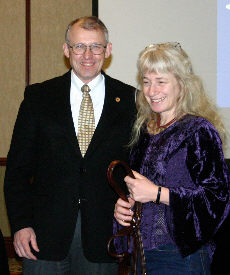
Sandy Rabinowitz received the FEI Disciplines
Award for Desdemona’s Wild Chance in the
freestyle dressage division.
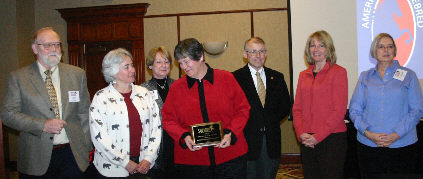
(L-R) William Blacklaw, Cynthia Preston, Shelagh Roell,
Ann Byers, Barbara Molland and Susan Vine headed up front
for the presentation of the ASHA Charter Club of the Year
to the Northwest Saddlebred Association.
Kyle Bailey, from The National Horseman Magazine, presented the Castleman Award to William Blacklaw and his late wife, Barbara, of Singing Hills Stable in Oregon.
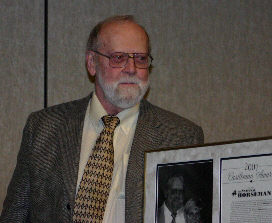
William Blacklaw accepted the Castleman Award
Nealia McCracken addressed the group about Saddlebred Rescue, which in just over two years has placed 300 horses in loving homes. Donations are always needed and to that end, Schones and Jampsa, LLC donated a stallion service to be auctioned off with proceeds going to Saddlebred Rescue. Kathy Capsuto and Paula Schmitt, bidding by phone got into a bidding war with Margo Baird, also bidding by phone. In the end it was Capsuto and Schmitt who won the service with a bid of $12,000.
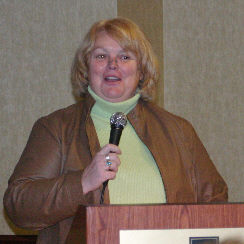
Nealia McCracken addressed convention-goers
regarding the success of Saddlebred Rescue.
The open forum “Challenges and Opportunities for the American Saddlebred” featured the panel of Alan Balch, Redd Crabtree, Dick Kearney, Nelson Green and Keith Bartz. They discussed everything from breeding, judging, regional championships and the state of the ASHA.
The panel was quick to give credit to the judging system of today. Redd Crabtree felt that judges should be able to explain their decisions. Dick Kearney emphasized that judges have to thoroughly know the rules. Nelson Green stated, “It’s much harder to be a judge now. Thirty or 40 years ago a judge could practice judging because they didn’t have to have a card at some of the smaller shows. Judges can’t do that nowadays.” Alan Balch said, “More attention is paid to improving judging in this breed over any other.”
Keith Bartz, head of the Licensed Officials Committee for USEF, told the group, “I believe our judging is in good order these days. It’s a man-sized job to stand in the center of a ring full of Saddlebreds.” He also went on to say, “Every licensed competition has forms that people can fill out about the judging at the show. Those evaluations get put in the judge’s file and the judge can respond. In all the divisions, sending in those forms was only taken advantage of 44 times.”
Newly elected to serve a three-year term on the ASHA Board of Directors, Carl Holden proposed that an oversight committee be formed to study the judging system.
Talk then turned to promotion of the breed and the current status of registrations, applications for registrations and what those numbers mean.
Alan Balch started off by telling the audience that Mr. and Mrs. Franklin Groves, along with an anonymous donor, have created a $100,000 challenge grant specifically for promoting and marketing of the American Saddlebred by ASHA. According to Balch, that amount will be matched by ASHA.
He went on to give data for 2007 regarding memberships, registrations and a comparison of those numbers to other breed organizations.
ASHA memberships in 1997 were 7,272, as compared to 8,799 in 2007, showing a positive increase. Registrations processed in 1997 were 2,708. That number increased to 2,740 in 2007 which is especially positive considering that registrations processed since 1997 have steadily declined for Arabians, Appaloosas, half-Arabs, Morgans, Paints and Tennessee Walking Horses. Quarter Horses and Thoroughbreds have shown an increase.
Registrations by foal crop, however, have shown a gradual decline. Between 1990 and 1996, the average was approximately 3,000. The 2006 numbers will show an increase but are not expected to reach 3,000. Transfers processed was also addressed as a serious concern by Balch.
In 2007, transfers processed were down 3.8 percent from the 5,200 transfers processed in 2001. Although that is a small number in comparison to the 55 percent decrease for Appaloosas, 38 percent decrease for Arabians, 36 percent decrease for Tennessee Walking Horses, 20 percent decrease for Morgans and an 11 percent decrease for half-Arabs, it still raised the questions “Why are people not keeping horses registered through successive owners?” and “Why should a horse be registered?”
Balch made it a priority to emphasize that the association was very aware of the problem regarding the backlog of registrations received versus actually processed. In 2007, 3,210 applications for registration were received, while only 2,740 were actually processed. He attributed that inordinately large number to the fact that most members were trying to beat the price increase that took effect Jan. 10, 2008. He assured the membership that the problem was being worked on.
Newly elected ASHA director Barbara Molland, along with Susan Vine and Shelagh Roell then took the stage to discuss regional championships. Molland stated, “The original intent of regional championships was to recognize outstanding effort and decentralize the industry.”

(L-R), Shelagh Roell, Barbara Molland and Susan
Vine, organizers of the Charter Club Council, took
center stage along with Alan Balch to talk about
ASHA regional championships.
Regional championships started with USEF regions, but effective in 2008 members will be able to declare a region they want to show in so that if they live in a different region, they can show somewhere else. Individuals are required to show at three shows and place first through eighth in whatever class they want to try to earn the regional championship title. The shows do not have to be USEF rated.
The following shows are designated as ASHA Regional Championships: NWSA Fall Classic, California Futurity, Arizona Futurity, Texas State Fair (new for 2008), Southeastern Charity, Kentucky Fall Classic, Mid America Mane Event (new for 2008), Eastern States (new for 2008), Penn National and Wisconsin Futurity.
The ASHA web site (www.saddlebred.com) also generated a lot of conversation and interest. Considered to be the cornerstone of the marketing program, numerous changes, for the better, are on the way, according to Balch.
“We are committed to service and the home page of the site will be fixed, “ he added.
Approximately $50,000 to $60,000 is spent per year on tech related matters on the web site. In 2005, the first year the Kentucky State Fair was web cast, expenses were $52,000 and zero dollars was generated as income. In 2006, expenses and income basically broke even at approximately $36,000 each. In 2007, expenses were $62,000 and income was $70,166. Approximately $40,000 of that income came from the web cast. Those numbers show that the web site can generate income for the association. To that end, the association is working hard to make the site more user friendly and adding much-needed features.
Some of the changes planned include having the membership directory available on a flash drive, pictures included on pedigree searches, the ability to export pedigrees from the ASHA web site to your own web site and the ability to easily find out how close your horse may be to obtaining their CH status. Horses with between 10-14 points will be listed by rank in hopes that it will encourage owners to show more in an effort to get the required points.
Balch also told the group that a recommendation will be made to the registry board for a fee increase once all the updates are done, so paperwork should be sent in now for horses that have all their points.
The association wants suggestions for improvement by the membership and discussion about the web site continued Saturday morning.
Friday afternoon also included several open committee meetings before things wrapped up in preparation for the museum festivities.
Friday night’s Saddlebred Museum Exhibit Opening and Reception was an elegant, well planned and entertaining event. While the youth enjoyed their pizza party, youth activities and dance party (see separate news item), the adults were enjoying great food, an open bar and a gorgeous array of exhibits at the soon-to-be-much-larger museum. Transportation from the Embassy Suites was provided and more than 225 people attended the event.
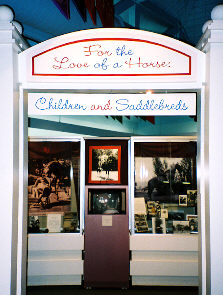
The new exhibit “For The Love Of A Horse –
Children and Saddlebreds” was showcased
at Friday evening’s museum gala.
Photo by museum staff.
The gathering was designed not only to showcase the gorgeous new exhibit “For the Love Of A Horse – Children and Saddlebreds” but also as a fundraising effort for the museum’s planned expansion in anticipation of the 2010 World Equestrian Games to be held at the Kentucky Horse Park. The addition, a “Showplace For Saddlebreds” was put into the works when it was announced that the games were coming to Kentucky.
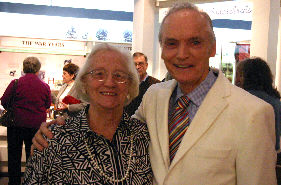
Alice Shiflet and Don Harris
visited at the museum.
Jane Simmons, daughter of the legendary trainer and author of the book Arthur Simmons – American Icon Of The Horse World, was on hand to autograph copies of her recently published book and she signed them almost non-stop as people lined up with books in hand.
Food stations with everything from roast beef to crudités were placed throughout the exhibit and provided a great way to keep the lines short and stomachs full.
For the first time in many years all of the permanent display panels detailing the history and versatility of the breed were in evidence.
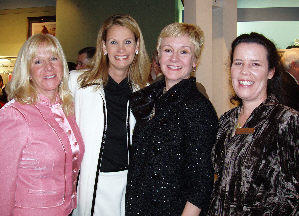
(L-R) Andi Bittker, Vickie Gillenwater, Kayce Bell
and Owen Weaver joined the more than 220
visitors at the museum gala.
Photo by museum staff.
Museum director Tolley Graves gave a short speech to the group, which included special recognition of the generosity of Dorothy and John Lenore. The Lenores have long supported the mission of the museum. John Lenore was on the board of trustees for nine years and served as president from 1995 to 2000. The Lenores pledged $500,000 to the capital campaign and donated that money in one upfront lump sum. With their help, the museum has raised more than 75 percent of the $3 million needed but still needs another $500,000. Graves also introduced Rob Hinkle, vice president of operations and administration of the World Equestrian Games.
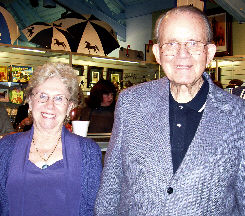
John and Dorothy Lenore received special thanks
at the Saddlebred Museum gala for their donation
of $500,000 for the planned Showplace For
Saddlebreds expansion and renovation.
Photo by museum staff.
Hinkle spoke about what is in store for the Horse Park and the museum during the 15-day event, which is expected to draw 500,000 visitors from 60 countries. The trade show and pavilion will take up the entire parking lot. The main drive will now split it in half and that drive will be the main exhibit avenue and will lead directly to the museum. That will put the museum in the unique position of being right in front of half a million visitors. In addition, plans also include a walkway that will make the museum directly accessible from the horse park.
Daily breed exhibitions and changing exhibit galleries, in addition to space to house and permanently display the museum’s collection of George Ford Morris paintings and prints are also part of the 6,750 square foot addition.
The World Equestrian Games will present an unprecedented opportunity to promote and educate the world about the American Saddlebred.
While the adults were encouraged to open their wallets to help fund the incredible expansion of the museum, the youth made an unscheduled stop at the museum Saturday morning and they had a great time touring the exhibits, many of which were interactive and hands-on, and shopping in the gift shop.
Museum Curator Kim Skipton conducted tours of the museum’s archives during the Friday night reception to show off the museum’s collection. Much of that collection is currently not on display due to lack of space. Storage will be expanded and upgraded in order to better preserve irreplaceable art and artifacts.
The youth began their Saturday morning bright and early with an awards breakfast at the hotel before heading off for their field trip (see separate news item).
The adults headed into one of the large banquet rooms for the first forum of the day: Saddlebred Breeders and Owners Educational Forum. Dr. B.A. Rucker, of Southwest Equine Services in Lebanon, Va., spoke about equine dentistry and some of the problems encountered that are unique to horses. His extremely informative presentation prompted questions from those in attendance.
Dr. Scott Morrison, from Rood & Riddle in Lexington, Ky., also gave an extremely informative presentation on foot care and shoeing for horses. He answered questions from the audience as well.
Both presentations were well done and well received and provided a great deal of much-needed information.
Alan Balch again headed to the front of the room along with outgoing ASHA President Fred Sarver and outgoing American Saddlebred Registry (ASR) President Joan Hamilton for the Open Membership Forum.
Balch reiterated his point from Friday regarding registrations of the American Saddlebred. He expanded on the backlog situation regarding registrations received versus processed by explaining the process. The registry gives first priority to registering foals of the current year. Of those foals, registrations are prioritized according to their applications. If there are no complications (wrong or incomplete information) those foals will be registered first. If there are problems with the application, they get set aside and wait in line.
ASHA has added more staff to help process applications. In addition, Balch explained that the current contract with the parentage lab at the University Of Kentucky will end in October 2008. Other options are being investigated including a new parentage lab at Texas A & M University. Balch worked so hard to reassure members that the association knows there is a problem and is committed to solving it that he gave out his cell phone number and said that he expected to receive a phone call if members felt they were not getting good service.
“Leadership Listens”, one of the new features on the web site, provides yet another way for members to offer suggestions and comments. Those comments however, are not anonymous, even if a member does not include their “optional” name or email address. Since members are required to log into the web site, the comments and suggestions, which go directly to Alan Balch, are identified with the user. All comments are shared with the full board of both the association and the registry.
Scarlett Mattson and Balch both discussed the new qualifying system for park and pleasure horses at the Kentucky State Fair. The topic was also addressed at the recent UPHA/AHHS National Convention in Roanoke, Va.
To briefly sum up the qualifying system, which is also explained on the ASHA web site, all championship winners from the 2007 World’s Championship Horse Show are automatically qualified for 2008 but they must show in six classes at three shows between July 1, 2007 and June 30, 2008 just like all the other horses trying to get qualified. If there are more horses entered in either division than spots available, points will be used to determine eligibility.
The goal of ASHA is to have every single competition, whether USEF rated or not, be included in the competition data. It is imperative that every single competition send in accurate and complete information to the association before the event and complete and accurate results after the event. Points awarded are the same whether a show is rated by USEF or not, but point value changes depending on number of class entries.
The qualifying dates of July 1–June 30 were chosen because of when the World’s Championship Horse Show is held and when entries close.
Balch closed the meeting by giving special thanks to Will Wood for his help with the web site and online video streaming of the convention and the crowd gave a standing ovation to ASHA Administration Manager Charlotte Tevis for her hard work in the association.
The Annual Membership Luncheon not only featured great food, but also a presentation to the winners of the silent auction items and keynote speakers. Alan Balch paid special recognition to Katriona Adams who was in charge of the Saddlebred Ball. Mrs. David Neil was also recognized for receiving the Lifetime Achievement Award although her formal presentation wouldn’t happen until the following night.
Dede Gatlin and Petra Green were both recognized for their 20 years of service to ASHA and Marcia Carothers received a standing ovation when Balch paid tribute to all her hard work.
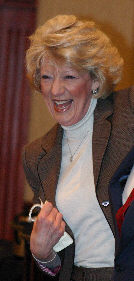
Marcia Carothers received a standing ovation
at the membership luncheon Saturday afternoon.
Paula Jo Briney, new ASHA Communications Director Jessica Fisher, Deborah Roxey, Dr. Margaret McNeese, Susan Vine, Jody Swimmer and Jimmy Robertson all had winning bids for the silent auction items.
Dr. Ernie Bailey from the University of Kentucky spoke to the crowd about the Lordosis Research Study that he is leading. The point of the study is to try to identify the genetic basis for Lordosis in order to make better management decisions.
Dr. Kathryn Graves, also from UK, discussed the research study at the parentage lab to identify the gene that causes Epitheliogenesis Imperfecta (EI) in Saddlebred foals. The condition, which is always lethal and particularly horrifying, causes large areas of skin on affected foals to not attach to their bodies.
A test for EI has been developed and the mutation has been identified. Belgian draft horses also can carry the defect but the mutation is completely different. The fee for the test is $50. Hair samples can be used or a stored sample that is already at the lab for DNA testing can be used.
Graves answered questions from the audience and explained that even if a mare or stallion is a carrier of EI, they can be used for breeding with absolutely no reservations as long as they are bred to a horse that is not a carrier. The carrier rate in Saddlebreds is approximately five percent. If a carrier mates with a carrier, only 25 percent of those foals will be affected which equates to approximately seven out of every 10,000 foals.
Deb Balliet, of the Equestrian Land Conservation Resource, spoke of the urgency to protect horse properties and some of the steps that can be taken to do so. The web site (www.elcr.org) won a national award from American Trails. Valuable information regarding the purpose and mission of the organization can be found at the web site. Balliet ended her presentation by saying, “No action is an action, just not necessarily the one you want.”
Jay Hickey, president of the American Horse Council, which represents the horse industry in Congress, also gave an informative presentation regarding the Economic Stimulus Act, signed into law Feb. 13, 2008 by President Bush that should be very beneficial to horse owners. Information regarding those new incentives can be found on www.elcr.org.
In the ASHA Annual Membership Meeting, nominations were accepted from the floor for the two positions available on the nominating committee, which will select candidates for the six available seats on the 2009 ASHA board of directors. Those in attendance at the meeting or voting by proxy nominated three members and Carole Reedy and Nancy Becker were elected.
The board of directors elected officers for the association in their meeting. In addition to Carl Holden, Dr. Margaret McNeese and Barbara Molland were also elected as new directors. Vicki Gillenwater, Paul Trieber and Art Zubrod were re-elected to the board to serve three-year terms.
Mary Ann Cronan was elected president of the board. Mary Ann Pardieck was elected first vice-president, Gillenwater is second vice-president, Trieber is secretary and Jim Ruwoldt is treasurer. Misdee Wrigley Miller did not seek re-election as first vice president but she did serve as chair for the nominating committee.
Elected to serve one-year terms on the board of directors of the American Saddlebred Registry were Cronan, Molland, McNeese, Jimmy Robertson and Judy Werner. Four seats on the board remain to be filled and the association’s officers nominating committee named seven candidates. Lisa Duncan, Brian Reimer, Bob Ruxer and Anne Stafford were elected to the registry board. Stafford was elected for the third year in a row.
Joan Hamilton, David Howard, Dr. Rick Luft, Spencer Mains, Pardieck, Dr. Alan Raun and Fred Sarver all stepped down from the registry board after three years of service.
Those in attendance at Saturday night’s Saddlebred Ball at Keeneland would be hard pressed to find an event in the Saddlebred industry more glamorous. The event this year was sold out and packed to the gills with 500 people in formal attire in attendance for the awards presentations, dinner and dancing.
The increase from last year was due in part to the fact that this year, Mother Nature smiled on the event with great weather and dry roads.
Alan Balch got the evening started after the cocktail hour with the evening’s first award. Standing ovations from the huge crowd were the order of the night and it was obvious in each acceptance speech that the honorees were thankful and honored.
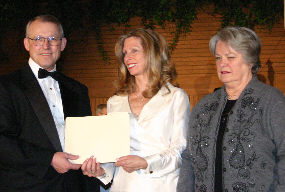
Tandy Patrick and Scarlett Mattson presented
Fred Sarver with a certificate representing a
check for $100,000 from the Kentucky State
Fair at Saturday’s Saddlebred Ball.
Michele Macfarlane headed to the stage along with Smith Lilly, who won the World’s Grand Championship diamond ring last year. Macfarlane was presented with a commemorative lapel pin for her win of the Five-Gaited World’s Grand Championship with CCV Casey’s Final Countdown.
Todd Miles, winner of the ring in 2005 was recognized at the dinner last year but his daughter, Macey, was home in bed with the flu. This year she was proudly sitting right beside her dad celebrating her birthday with the other 498 people in the room and Balch led the whole group in singing Happy Birthday to her.
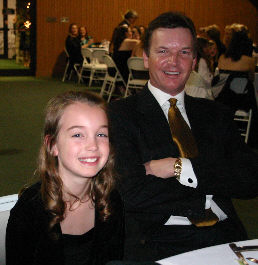
Everyone sang happy birthday to Macey Miles
who celebrated with her dad, Todd.
With the big band sounds of Swingtime adding to the festive atmosphere, Kelly Hill was next to head up front. She was presented with the Frank Ogletree Youth Award.
Martin Gueldner of Germany won the Gordon Jenkins International Award for promotion of the Saddlebred outside the United States.
Marilyn Macfarlane and everyone else got a kick out of the cute video showing old pictures of favorite horses, ponies, friends and family when she accepted the Lurline Roth Sportsmanship Award.
George and Maggie Robertson were presented with the Meritorious Service Award. Their acceptance speeches were brief and heartfelt as well.
Bud Willimon was overwhelmed when he received the C.J. Cronan Sportsmanship Award in part because he knew Cronan and the type of man he was.
Tony Weldon accepted the Breeder Of The Year Award for the second year in a row on behalf of Callaway Hills. After an exceptionally difficult year, Weldon’s speech was emotional while she accepted her second award.
Ann Tierney Smith, Leatherwood Stud, seemed almost baffled when she was named to the ASHA’s Breeders Hall of Fame. “It seems odd to receive an award for something you love so much,” she said.
Vickie Gillenwater presented the Paul and Dorothy Gillenwater Family Award on behalf of her late parents to the Wheeler family. Ceil and daughter Catherine accepted the award on behalf of the entire family.
Kathie Dunn accepted the Wing Commander Medal for Bob Lewis and Carter Cox took the stage to accept his medal.
Neil Visser, Joan Hamilton and Misdee Miller were presented with the ASHA Horse Of The Year Award for Grande Gil, the 2007 Three-Gaited Triple Crown Champion.
The thunderous applause and standing ovation seemed to go on forever when Anne and Sam Stafford and Mrs. David Neil took the stage after a speech by Alan Balch and a memory-evoking video of Betty Neil’s life with her late husband, David Neil, and Blythewood Farm. She was presented with the Lifetime Achievement Award (see separate news item).
Special tribute was paid to Fred Sarver for his service to ASHA as president. Sarver, joined by his wife, Karen, addressed the crowd to thank them for letting him serve as president and tell them how much he had enjoyed the job.
It was an incredible end, in high style, to cap off a successful, informative convention.
|